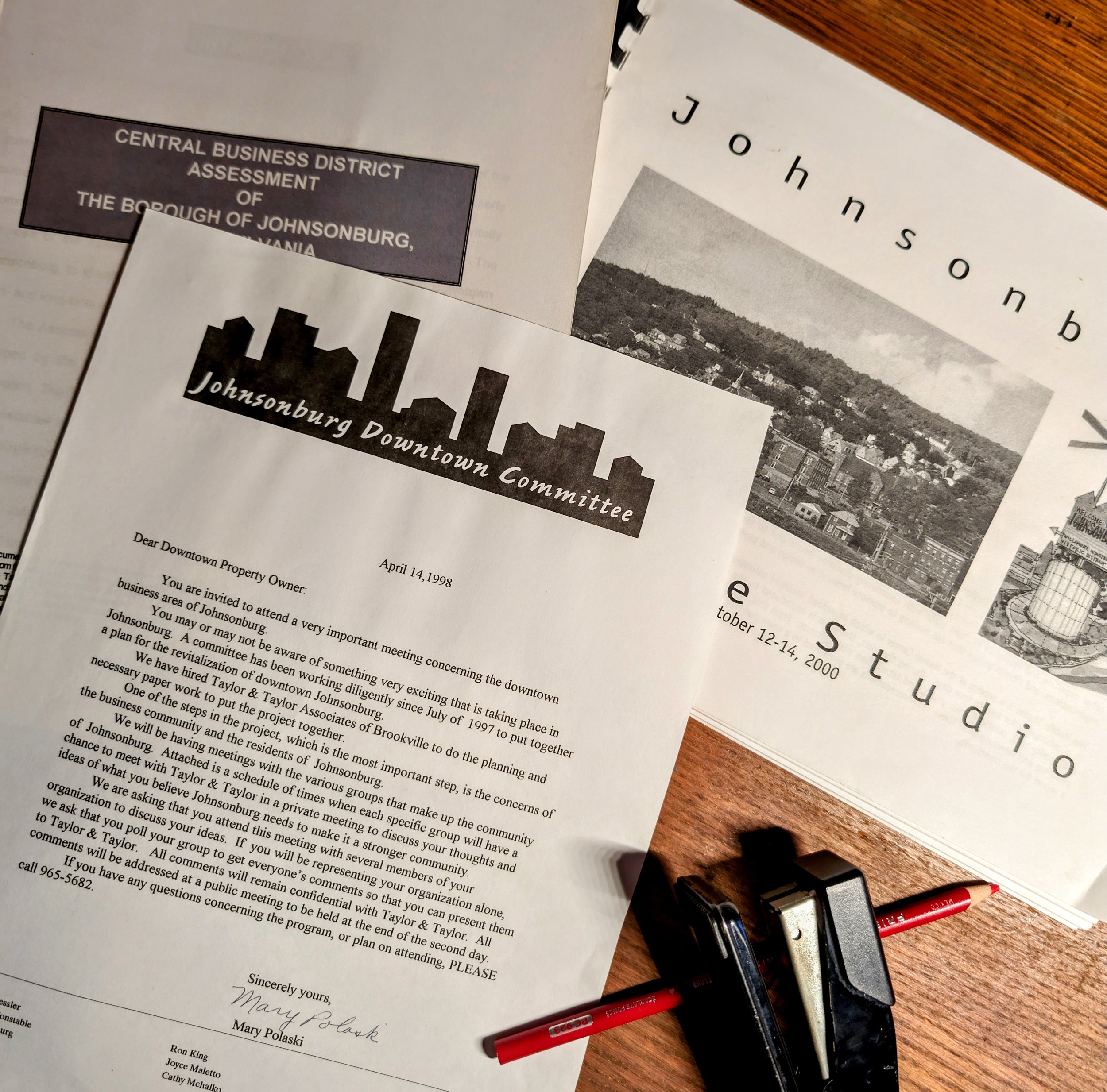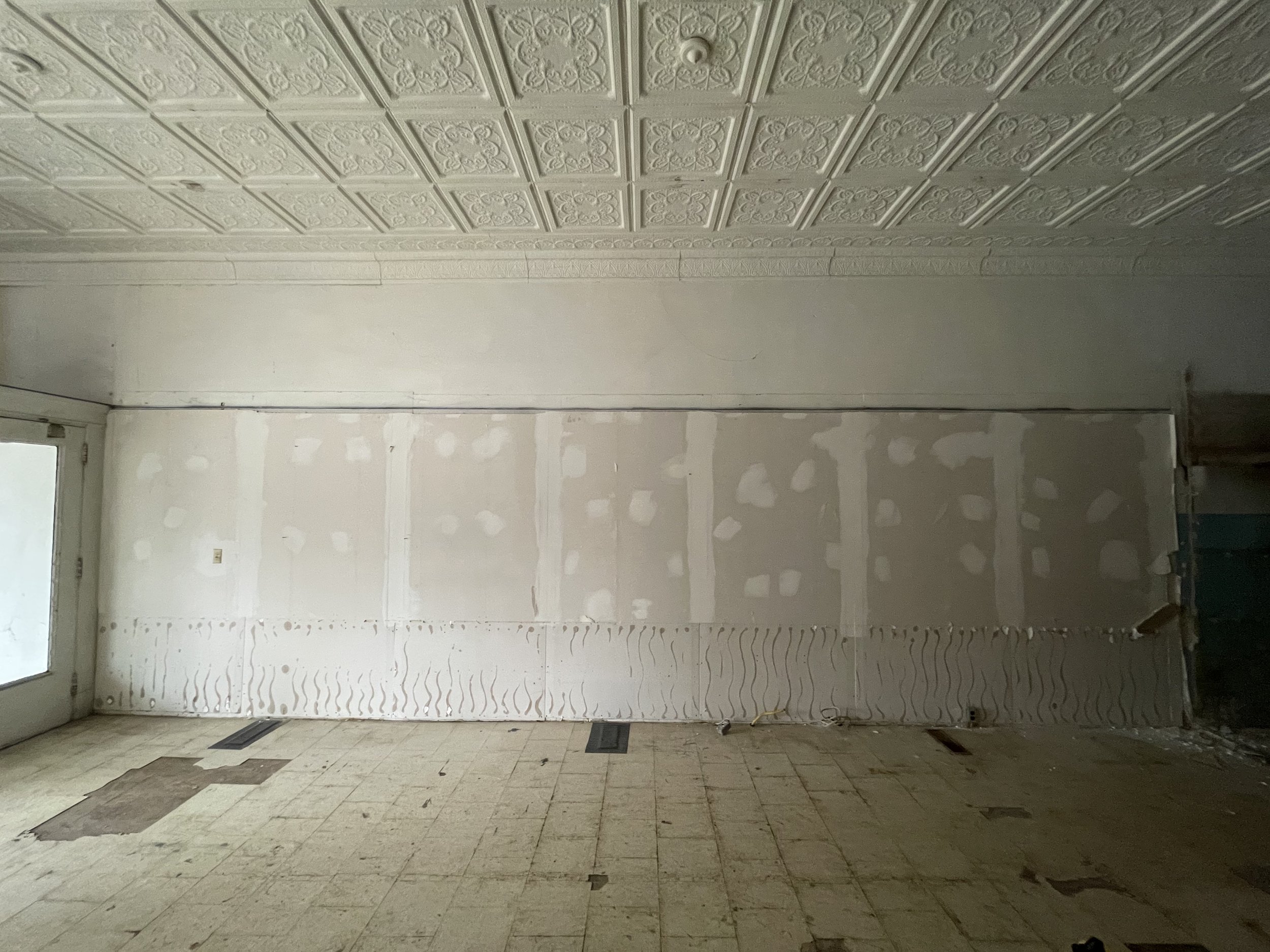papers and letters from 1997, 1998 and 2000
A passionate group of individuals started meeting midsummer 1996 to brainstorm on how to bring back Johnsonburg. They were from organizations, businesses, local government, the borough and also, private individuals. All with a deep connection to the town and were, honestly, movers and shakers. Starting simply with the creation of, what was called, the Downtown Committee, the precursor to what would be the Johnsonburg Community Trust, they formed a plan. Members of this original group were Chris Bressler, Charlie Constable, Dan Freeburg, Ron King, Joyce Maletto, Cathy Mehalko, Mary Polaski, Harriet Stahli and Steve Vallone. These pioneers started making phone calls, establishing funds then ultimately hiring a consulting service out of Brookville, Taylor & Taylor Associates. The Johnsonburg Community Trust (JCT) was formed in 1997. From here, the JCT directors began the process of becoming a non-profit - they were incorporated in the fall of 1998, bylaws were adopted, their mission statement was written and thus began the laborious process of applying for the historic section of downtown to be placed on the National Register of Historic Places, received September 27, 1999. This designation, the name Commercial Historic District, was extremely important to the growth of downtown..
As written in the National Register of Historic Places, 1999, Section 7 page 1:
The Johnsonburg Commercial Historic District is a 6-acre district which contains the extant historic buildings of the central business district of the Borough of Johnsonburg, located in Elk County, in north-central Pennsylvania. The community is small and rural in character, although heavily industrialized, and lies at the confluence of two branches of the Clarion River, nine miles north of Ridgway, the county seat. The buildings within the district date from between 1890 and the late 1930s, are primarily of brick, and are of two and three stories in height. The architectural styles evident within the district include Italianate, Colonial and Neo-Classical Revivals, and Art Deco; some buildings are built without reference to any academic style. The district includes portions of Center Street (U. S. Route 219) and Market Streets, which run roughly parallel to each other, and Bridge Street, which connects the two streets at right angles near the south boundary of the district. Just outside the district, at the north end of Market Street, the Williamette Paper Mill physically dominates the skyline of the northern terminus of the district. Thirty-eight individual resources are in the district, of which thirty-three (85%) contribute to the character of the district and five (15%) are non contributing. Of the thirty-eight resources in the district, thirty-seven are buildings and one—a piece of religious statuary—is a contributing object. Approximately 20% of the buildings in the district were built between c. 1890 and 1900, about 70% between 1900 and 1945 and approximately 10% after World War II. The district contains one residential building, one industrial building, and three institutional buildings; the remainder are primarily commercial.
United States Department of the Interior
National Park Service
National Register of Historic Places
Registration Form
JCT’s mission statement:
The Mission of the Johnsonburg Community Trust is to promote, obtain and administer revitalization projects for the Borough of Johnsonburg in order to attract new retail businesses and improve the business opportunities for existing retailers, in a way that:
1. Creates an appealing shopping environment by enhancing our existing building structures and architecture designs.
2. Utilizes and takes advantage of our region's rich natural resources and history to promote tourism and related businesses.
3. Includes ideas and input from all sectors of our population, both business and residential.
4. To improve the quality of life of the community of Johnsonburg by educating the general public as to the heritage of the community, by historic preservation, by aesthetic improvement and by the development of the arts.
In 1997 the JCT committees were formed including the Preservation/Design Committee, Arts Committee, Nominating Committee and Finance Committee. Public meetings were scheduled, a Central Business District Assessment was complete and streetscape contractors were invited to place bids and grants written to begin a facade program. In 2000, the Hamer Center for Community Design Assistance, which is an outreach unit from the School of Architecture and Landscape Architecture at Penn State University developed an action plan. The recommendations of their Mobile Studio team represents four areas of action which include Community Entrances, Downtown Streetscapes, Community Greenways and Community Building and Networking.
Many of these strategic projects were implemented throughout town including tree plantings, commercial building facades, signage and more. Business owners were often contacted about how they could be a part of downtown revitalizations and grants were written.
The 2008 Our Town Johnsonburg at WPSU studio’s in St. College. Volunteers from Johnsonburg answering phones and raising money.
As the years went by the JCT took part in two WPSU Our Town series, one in 2008 and the other 2016. Funding for murals painted by the talented artist Tom Copella took place in 2014 and 2015 and, in 2019, the Johnsonburg Community Center had an overhaul of its playground.
Come June 2020, a first happened for this non-profit - the purchase of a 45,000 sq ft Armstrong Real Estate and Improvement Company's Brick Block building. This 1890’s brick structure holds great importantance architecturally, for it occupies ¼ of the downtown’s Commercial Historic District. Up to that point the JCT had never owned property but, if the 12 bay structure were to be demolished a huge portion of the district would not exist. The group became obsessed with saving the Brick Block with its multiple storefronts, recessed arcade, and lively profile. For months volunteers removed tons of debris and also made this 130 year old building weathertight and as structurally sound as the times permitted.
A Rehabilitation Plan was created/implemented for the Brick Block (BB), volunteers continued working hard to save the BB, all while the directors held events, fundraisers and completed other community projects. Starting in 2021, plans were made to build out a Heritage Education & Welcome Center in the first unit of the BB, located on the corner of Bridge and Market Street. This essential build-out would become a place for historical displays, classes & educational workshops, the JCT office, events, retail space for local artisans and an umbrella for other non-profits, welcome center, etc.
Coming into 2022/2023, the JCT is continuing to work with the borough on greenspaces through town as well as other upcoming projects throughout 2024.. Many, many exciting ventures are continuing to unfold including a Community Economic Development Coordinator being hired that the borough will share, 20 hrs in Johnsonburg and 20 hrs in Ridgway. We also partnered with Leadership Elk & Cameron on the Together We can Make a Difference survey in 2022. A very successful New Year’s Eve Party had its inaugural event 2023, Illuminate the Memories in its forth year, Casino Night now in its second year, as well as the Alumni & Friends Reunion Event now celebrating 20 years for 2024.
JCT directors at the Johnsonburg Community Center, at January 2024, meeting looking at donated original maps of a section of Johnsonburg, then Rolfe.
directors: Stephanie Distler, Arianne Iorfido, Harv Davison, Lauren Pura, Dawn Karellas, Kyle Paget, Andrew Mohney and Christina Tigani, present. Missing: Shannon Gitterman and Becky Durian
Look for more information coming out on the Johnsonburg Community Trust’s Heritage Education & Welcome Center, upcoming events, how to volunteer and also, support our mission through the website www.johnsonburgcommunitytrust.com and on Facebook or Instagram.
by Stephanie Distler
5th generation JBG native
JCT, president


















